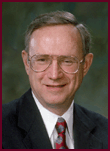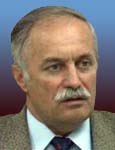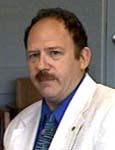
Shuttle-Mir Team Members (H - K)
Go
to
![]() Team
Members
Team
Members![]() Group (A -B)
Group (A -B)
Go
to
![]() Team
Members
Team
Members![]() Group (C - D)
Group (C - D)
Go
to
![]() Team
Members
Team
Members![]() Group (E - G)
Group (E - G)
Go
to
![]() Team
Members
Team
Members![]() Group (L - N)
Group (L - N)
Bob Hesselmeyer Profile
Bob Hesselmeyer was the NASA Group Leader in the Configuration Management Control Sub Group. This group established standards and controls for documents and communications.
Working Groups consisted of experts from RSC Energia, NASA, RSA, Institute for Biomedical Problems (IBMP), Gagarin Cosmonaut Training Center (GCTC), and other organizations and companies. A list of the Working Groups, their areas of responsibility, and the names of their co-chairs can be found at the Working Group Structure.
![]()
 Albert
W. "Al" Holland Profile
Albert
W. "Al" Holland Profile
Al Holland, a NASA psychologist, supported the operations of Phase 1. His duties included analyzing the astronauts' personality traits and matching them with their suitability for long-duration flight.
After the U.S.-Mir astronauts were chosen, Holland gave them psychological training in preparation for their stays on the Russian outpost. Part of this training came from knowledge gained during Soviet long-duration flight experience in the Soyuz and Mir eras, as well as from lessons learned from polar traverses, undersea missions, and submarine missions - all closed environments such as the Mir astronauts would find on the Russian space station.
He also trained the astronauts and their families in Russian culture to prepare them for their visits overseas in a foreign country. Additionally, Holland communicated with the Mir astronauts over ham radio during their flights and monitored air-to-ground transmissions. He set up weekly communications with the U.S.-Mir residents and family members. Post-flight support included debriefing the Mir traveller for knowledge that would be passed on to future residents.
In his Oral History, he provides this overview of his duties: "Basically, what I was employed to do was to do all things psychological, which includes selection, psychological selection, the psychological aspects of training for long-duration flight, in-flight support. We had a full in-flight support program. In-flight monitoring, and post-flight debriefs for all the crew members and also their families, tracking their families throughout pre-flight, in-flight, post-flight phases, and making sure that the flyers reintegrated well, back into the office and the families."
![]()
 Tommy
Holloway Profile
Tommy
Holloway Profile
Tommy W. Holloway served as the first Manager of the NASA Shuttle-Mir Program beginning in October 1994, when Phase 1 became a formal stand-alone NASA program. He continued in this position until August 1995 when he was assigned as the Manager for the Space Shuttle Program.
Early in the Phase 1 Program there was some uncertainty over whether Phase 1 was more part of the Space Shuttle Program - because of all the rendezvouses and dockings that were necessary - or more part of the Space Station Program - because of long-duration astronaut residencies onboard Mir.
Frank Culbertson, who followed Holloway as Phase 1 Manager, says in his Oral History, "Tommy Holloway did a really good job of pulling together a compromise ... that established a program office - a framework of working groups with which to negotiate and work the issues... Some of it was based on the Apollo-Soyuz experience ... [and] some of it was just good common sense."
According to Culbertson, "Tommy put together this ... so that everybody [agreed]: 'This is the way we're going to manage this program. This is the way it's going to exist.' And he was able to establish a budget for it, a schedule, and everything. And I thought that that was the real foundation of our success - was that early work Tommy did in that area. A lot of other people worked in it, too, but Tommy's the one who finally pulled it all together."
Holloway began his career with NASA in 1963, planning activities for Gemini and Apollo flights in the Mission Control Center. He was a flight director in Mission Control for early space shuttle flights and became chief of the Flight Director Office in 1985.
In 1989, he was named Assistant Director for the Space Shuttle Program for the Mission Operations Directorate. In 1992, he became the Deputy Manager for Program Integration with the Space Shuttle Program; in 1994 he was named Director of the Phase 1 Program.
Holloway was named manager of the Space Shuttle Program in August 1995. He became Manger, International Space Station Program, in April 1999. On September 30, 1999, he received the prestigious Robert R. Gilruth Award, given to recognize outstanding managers of operations, engineering and science programs.
![]()
 Carolyn
Huntoon Profile
Carolyn
Huntoon Profile
Carolyn Huntoon was the Director of the Johnson Space Center during the first part of Phase 1. She was appointed as Director in 1994. Huntoon joined NASA in 1970 as a life sciences researcher and has served in a number of key roles for the Center.
NASA scientist John Charles commented in his Oral History on one aspect of Huntoon's role in Phase 1:
"I give Carolyn Huntoon a great deal of credit for introducing the idea of statistics in the Russian space medicine program, because the folks she worked with ended up doing T-tests on some of their metabolic studies they did in flight, and that was the first evidence I've ever seen in my reading of statistics in the Russian space medicine publications. "And I know it's because she hounded them to do it, or maybe she did them [the tests] for them and gave them back to them." Carolyn Huntoon was the Director of the Johnson Space Center during the first part of Phase 1. She was appointed as Director in 1994. Huntoon joined NASA in 1970 as a life sciences researcher and has served in a number of key roles for the Center.
NASA scientist John Charles commented in his Oral History on one aspect of Huntoon's role in Phase 1:
"I give Carolyn Huntoon a great deal of credit for introducing the idea of statistics in the Russian space medicine program, because the folks she worked with ended up doing T-tests on some of their metabolic studies they did in flight, and that was the first evidence I've ever seen in my reading of statistics in the Russian space medicine publications.
"And I know it's because she hounded them to do it, or maybe she did them [the tests] for them and gave them back to them."
![]()
Dan Jacobs Profile
Dan Jacobs was the NASA Chairman of Institutional Communications working group.
![]()
 Brent
W. Jett Profile
Brent
W. Jett Profile
Astronaut Brent Jett participated in the Phase 1 Program as the pilot of STS-81 and as a Director of Operations (DOR) in Russia. Additionally, Jett piloted STS-72 and STS-81, which was the fifth Shuttle-Mir docking.
As DOR, he was responsible for the coordination and implementation of Phase 1 mission operations activities between Russia and NASA, managing a vital support system office in Star City, Russia.
In his Oral History, Jett spoke about the importance of cultural understanding: "As a DOR, . . you would occasionally get in situations, and usually they were social type of situations where you would not have an interpreter with you. . . so you needed to be able to follow a conversation, at least get the gist of what people are saying. As the NASA representative, in many cases you'd be the only NASA person there, and you would be called on or asked to say a few words, you know, a toast or something like that. So it's important that you be able to be at least that proficient in Russian, and I kind of was told that. Mike Baker, having been my commander on 81 [STS-81], having been a DOR previously, he gave me a lot of good advice about where to concentrate my Russian language studies. So that's what I did."
He was selected as an astronaut in 1992. Prior to his NASA career, Jett was a naval aviator in the U.S. Navy, and he attended the Navy Fighter Weapons School (Topgun). Jett earned a Bachelor of Science degree in aerospace engineering from the U.S. Naval Academy and a Master of Science degree in aeronautical engineering from the U.S. Naval Postgraduate School.
![]()
 Gary
W. Johnson Profile
Gary
W. Johnson Profile
Gary Johnson was the NASA Group Leader for the Safety Assurance Working Group. This working group was responsible for the evaluation of safety requirements of the Shuttle-Mir Program.
Johnson's expertise in working with the Russians began when he was a young electrical engineer with the Apollo-Soyuz Test Program in the mid-1970s. These experiences prepared him understand the cultural differences of the countries encountered as part of the Shuttle-Mir Program. The following is an example he shared during a Phase 1 Oral History:
"We always [tend] to write everything down. In other words, before I remember anything, when somebody tells me about something, if I really want to retain it, I need to write it down. And we're always taking written exams in school and so forth. The Russians, on the other hand, everything's done orally. All their exams are orally. All of their instructors give oral briefings. There's very little in the way of textbooks or written material.
"Our astronauts have had a problem with that when they go to Russia to train, because everything's provided oral[ly] and they've having to [take] oral exams. We're used to doing everything in writing.
"The Russians, at the same time, have trouble understanding why we have to have everything written down. I didn't understand that [un]til Shannon Lucid came back. She said when she was on the Mir, they would tell her something and she'd say, 'Wait a minute. Let me write it down.' They said, 'No, you don't have to write it down. You remember it.' "
![]()
Gaylen Johnson Profile
Gaylen Johnson was a NASA Group Leader for the Medical Operations Working Group. This group was responsible for defining the requirements for health care systems in support of astronauts and cosmonauts involved in cooperative missions.
Johnson served as the Flight Surgeon for the second Shuttle-Mir increment, serving as a communicator and providing for her physical and psychological well-being.
In his Oral History, Mir astronaut David Wolf talks about the importance of flight docs. Wolf said: "The flight surgeons take on a new importance in a mission like this. They do more than what would traditionally be considered flight surgeon work. They are your alter ego. They're yourself on the ground, and they know the people you need to talk with and communicate with."
According to Wolf, flight surgeons were the Mir astronauts' "gateways" for all sorts of information and communication.
![]()
 Yuri
Kargopolov Profile
Yuri
Kargopolov Profile
Yuri Kargopolov from the Gagarin Cosmonaut Training Center served as the co-chair for the Crew Training and Exchange Working Group. This group developed the requirements for crew functions, programs, schedules, and crew training. Kargopolov joined the Cosmonaut Training Center in 1974.
His career with the space program spans several decades, including the Apollo-Soyuz Test Project. In his Oral History, Kargopolov commented on the significance of the two countries working together - in the mid-1970s and in the 1990s:
"I remember how we were watching the ceremonial opening of the hatches between the docked Apollo and Soyuz vehicles and how both commanders shook their hands. That was a very neat thing to witness. It's a great thing now to really understand that that handshake allowed us to be where we are right now, and it's great to see that after so many years we are again working together and doing something so useful."
Prior to his career at the Center, Kargopolov served in the Air Force. He also attended and graduated from Zhukovsky Military Engineering Academy.
![]()
 Gary
H. Kitmacher Profile
Gary
H. Kitmacher Profile
Gary Kitmacher was NASA's project manager for the Mir module, Priroda. Launched on April 23, 1996, the Priroda was the last module sent to the Russian Space Station. This module contained U.S. science and systems hardware in support of the American science to be conducted while the astronauts resided on the Mir. In his Oral History, Kitmacher commented on his opportunity to lead the Priroda effort:
"There was already an ongoing effort to put science hardware onboard the Spektr module. The Spektr, which was one of the modules of the Mir station, carried much of the life sciences hardware. The Priroda was a little bit different, in that the Priroda module was going to support a great deal of Earth observation activity and, from the science aspect, from the NASA science aspect, was going to support microgravity experiments, which is really more of my forte ."
After his Priroda duties, Kitmacher supported the Mir Operations and Integration Working Group (MOIWG). This team was the joint NASA/Russia working group responsible for placing hardware onboard Mir and ensuring that NASA and Mir astronauts were trained to properly operate that equipment. He established much of the configuration management and program management associated with that working group.
Prior to his Priroda duties, Kitmacher was the mission manager for STS-60, the first flight of the Phase 1 Program, and the mission that included Sergei Krikalev, the first cosmonaut to ride on a shuttle. Kitmacher has also been involved in the design of the International Space Station and was associated with the Spacehab project. The Spacehab is a commercial module that was developed to support U.S. science onboard the space shuttle.
A career highlight occurred when U.S.-Mir Astronaut Shannon Lucid honored him with the Silver Snoopy award. The Silver Snoopy represents the astronaut corps' recognition of an individual's outstanding performance in support of the human spaceflight program. In his spare time, Kitmacher enjoys building models of the Mir and the Space Shuttles.
![]() Go
to Team Members group (A - B)
Go
to Team Members group (A - B)
![]() Go
to Team Members group (C - D)
Go
to Team Members group (C - D)
![]() Go
to Team Members group (E - G)
Go
to Team Members group (E - G)
![]() Go
to Team Members group (L - N)
Go
to Team Members group (L - N)